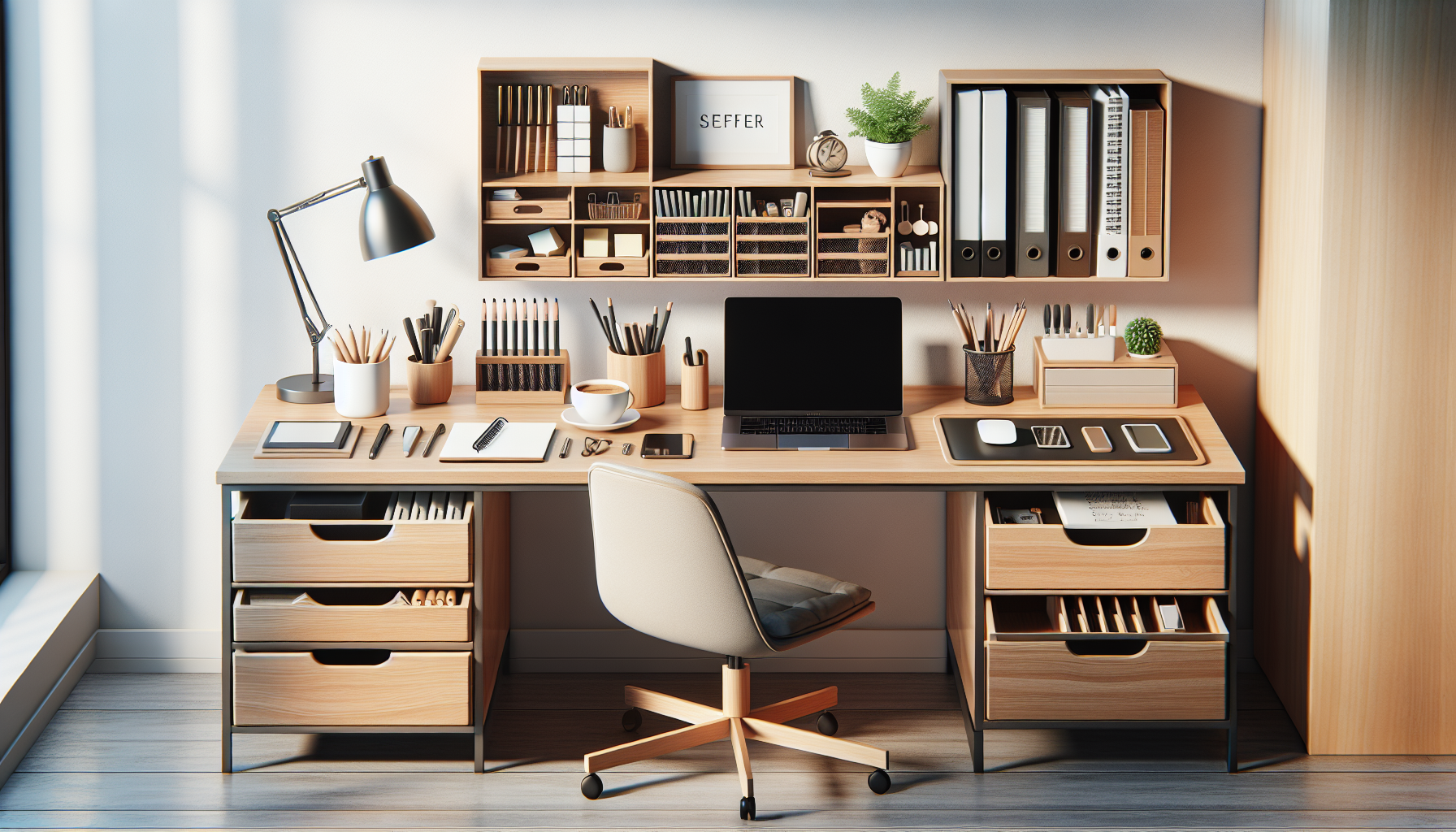Your cart is currently empty!

Organizing Hacks for a Clutter-Free Desk
1. Prioritize Minimalism for Enhanced Focus
Adopting a minimalist approach serves as the foundation for maintaining a clutter-free desk. Begin by assessing your current workspace and meticulously removing any non-essential items. Limit your surface area to essentials like your computer, a pen holder, and a small notebook. This not only enhances focus by minimizing distractions but also contributes to a calming atmosphere conducive to productivity. Implement the one-in-one-out rule: whenever you add a new item to your workspace, remove an existing one to maintain balance.
2. Categorize and Compartmentalize Office Supplies
Utilizing organizational tools is crucial in keeping your desk orderly. Opt for drawer organizers to compartmentalize office supplies such as pens, paper clips, and sticky notes. Label each section to streamline retrieval and ensure that every item has a designated storage spot. This method reduces the time spent searching for materials and maintains consistency in your organizational practices. For desks without drawers, consider using stacked desktop trays or small storage boxes to compartmentalize.
3. Embrace Vertical Space with Smart Solutions
Maximizing vertical space expands your storage capacity without encroaching on valuable desk surface real estate. Install shelves above your desk to store books, files, and decorative items. Use wall-mounted organizers or pegboards to hang office supplies, calendars, and essential documents within arm’s reach. Magnetic strips can hold metal items like scissors or notepads, offering an innovative solution to clutter. Additionally, corkboards can pin memos, maintaining an organized vertical filing system.
4. Implement Cable Management Techniques
Tangled cords and cables contribute significantly to visual clutter. Adopt cable management solutions such as cable clips, sleeves, or boxes to keep cords neatly aligned and out of sight. Label each cord for easy identification, preventing unnecessary confusion when connecting or disconnecting devices. Consider wireless charging options for devices or integrating a docking station to centralize power connectivity, thereby reducing the cable chaos that often plagues workspaces.
5. Digitize to Minimize Paper Clutter
The transition to a paperless desk cuts down significantly on clutter. Use a scanner or smartphone apps to digitize documents, receipts, and notes. Store these files in organized digital folders on your computer or cloud service to enhance accessibility. This approach not only frees up space but also facilitates efficient document retrieval. Invest in a reliable shredder for old documents containing sensitive information that you no longer need in physical form.
6. Utilize Multi-Functional Furniture
Furniture pieces that offer multiple functionalities can eradicate clutter by serving dual purposes. Invest in a desk with built-in storage solutions such as drawers, shelves, or cable management systems. A desk with a pull-out keyboard tray can also keep the surface free for other essential items. Adjustable desks that transition between sitting and standing can improve posture while keeping in line with minimalist principles by reducing the need for excessive furniture.
7. Regularly Refresh and Declutter
Establish a routine to refresh your workspace, scheduling decluttering sessions weekly. Take 5-10 minutes each day to tidy your desk surface, putting back items in their designated spots. Review storage areas monthly, ensuring they remain organized and free from obsolete materials. Regularly cleaning your workspace not only preserves the system you’ve established but also maintains a healthy and inspiring work environment.
8. Personalize with Purpose and Restraint
While maintaining order is quintessential, personalizing your workspace can boost morale and creativity. Select decor items that inspire, such as a favorite photo, plant, or artwork. Limit these to a few pieces to prevent a cluttered appearance. Plants, specifically, provide numerous benefits like improved air quality and reduced stress, making them ideal desk companions. Ensure that decorative elements enhance rather than detract from your organized setup.
9. Utilize Task Lighting Strategically
Good lighting is pivotal in maintaining productivity and reducing clutter. Opt for adjustable desk lamps that provide adequate illumination and alleviate strain on your eyes. Desk lamps with built-in organizational features such as pen holders or USB ports offer additional benefits by saving space and keeping essential tools within reach. Position the lamp to minimize shadows and glare on your computer screen for optimal clarity and comfort.
10. Leverage Mindful Technology Use
Incorporate technology mindfully to streamline tasks and reduce reliance on physical space. Use digital task managers and apps to record to-do lists and reminders, replacing sticky notes and notepads. Voice-activated assistants can automate tasks like setting timers or reminders. Implement noise-canceling headphones or sound machines to limit auditory distractions and maintain concentration, contributing to an efficient and clutter-free desk environment.
11. Foster an Organized Desk Mindset
Finally, cultivating an organized mindset is key. Approach your workspace with the intention of cleanliness and order. Train yourself to evaluate the necessity of each item and establish a habit of returning things to their rightful places. Embrace habits such as filing documents immediately, addressing daily clutter, and committing to regular evaluations of desk organization. This mindset shift ensures not only a physical transformation of space but also a long-term commitment to maintaining a clutter-free desk.
by
Tags:
Leave a Reply